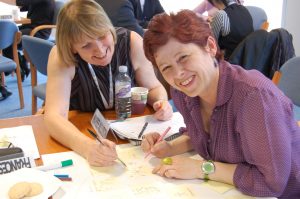Snook have been working with the Scottish Social Services Council to explore how Knowledge Management can be improved inside this organisation.
During initial discussions it became clear that knowledge is interpreted purely as information databases. Knowledge portals were brought up as ‘good’ examples of where knowledge was stored and could be used within the organisation. How can ‘improvement’ and innovation be driven inside the organisation and improve customer experience?

We tackled this question by mapping out the ‘journey’ an ‘insight’ goes on to become an ‘idea’. We visually depicted how insights travel through this particular organisation – considering how ‘touchpoints’ could be interpreted as a conversation, a form, a meeting or a decision.

Similarly to how services can be journey mapped through touchpoints over time, we used the same lens to look at the flow of an idea. This enabled us to break down the journey of ideas and identify pressure points where a form, conversation or meeting could be re-designed to stop an idea from becoming ‘lost’ in the system or slowed down because of organisational processes.

We worked with examples like Yammer – a great piece of technology that could potentially gain traction in this organisation. We used scenarios to help the team understand the context – if a member of the operations team discovers a problem with a form how can they fix this quickly?
We generated many small touchpoints that could be altered to improve idea flow within the SSSC as well as events that could be introduced to encourage staff to bring forward ideas. The difficulty in these sessions is a want to change the entire system.
Snook believe organisations should test ideas quickly and cheaply. Changing small things have an impact but changing many small things leads to a change in culture and environment. A culture is made up by the material products, systems and environments. We are excited about the possibilities that present themselves when organisations look at thier culture through the lens of design. This notion is at the heart of my ‘Embedding Design’ work – my work proved that even small aesthetic changes could be made to create a more collaborative culture. For example, simple things like hanging work on the wall created conversations, bringing in round tables created equality at meetings and a dedicated ‘project room’ showed the development of projects inside the organisation. Of course, these are all small changes but the important thing is they altered behaviour.
Yes, sometimes systems do need changed, and in our current economy and political backdrop there are bound to be huge changes afoot but incremental change can also make a difference!
We’ll be catching up with the SSSC later this month to look at how the team are driving ideas and innovation forward inside their organisation.
If you want to talk more about culture change and designing creative environments inside your organisation get in touch!
